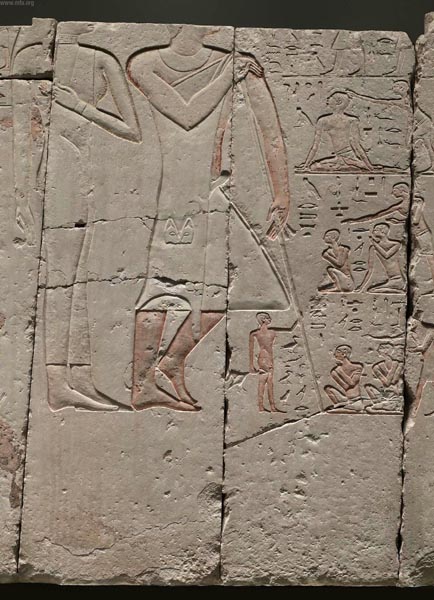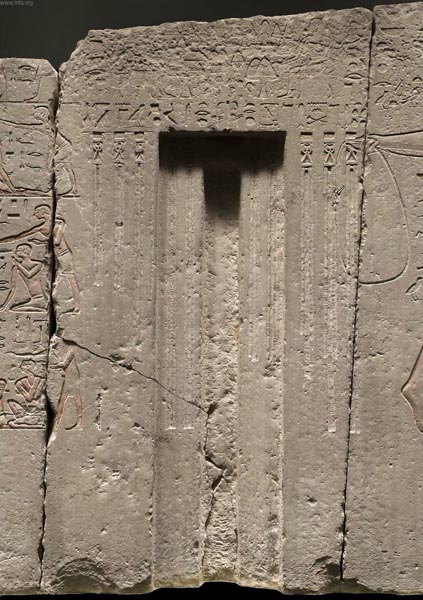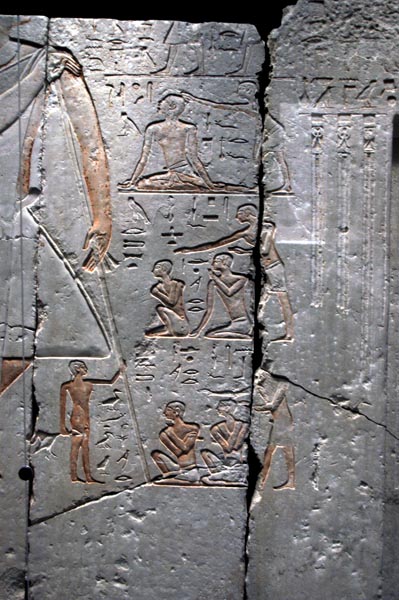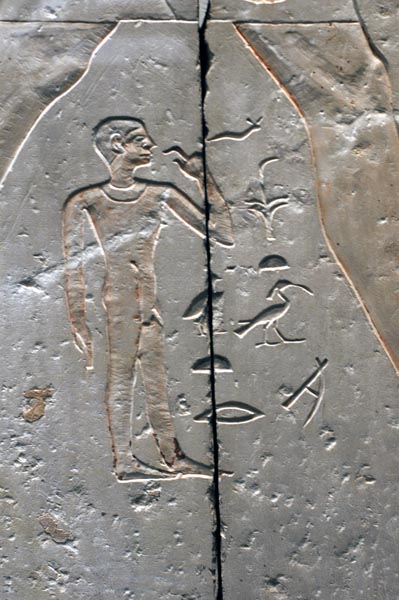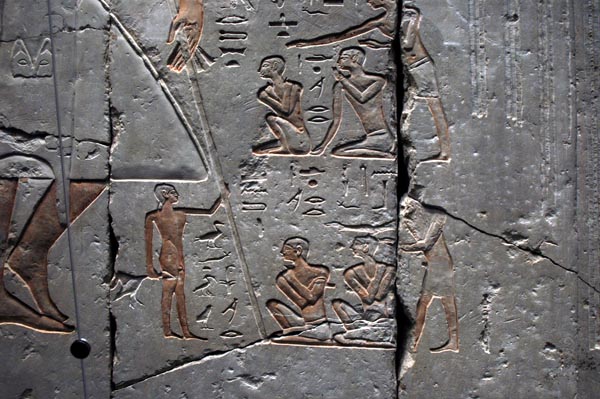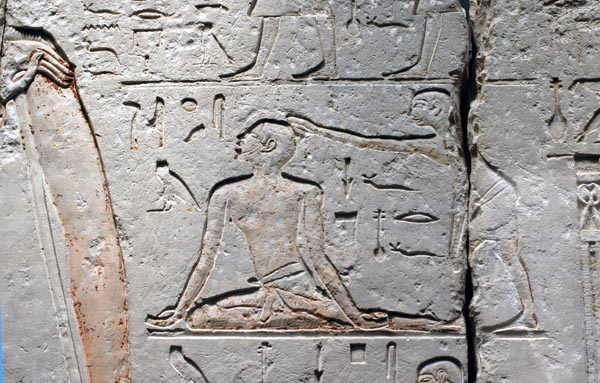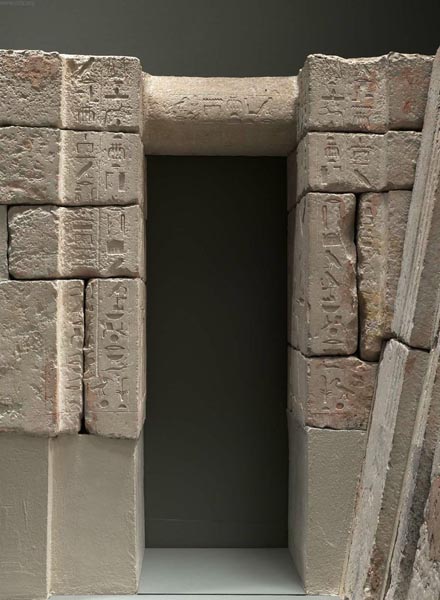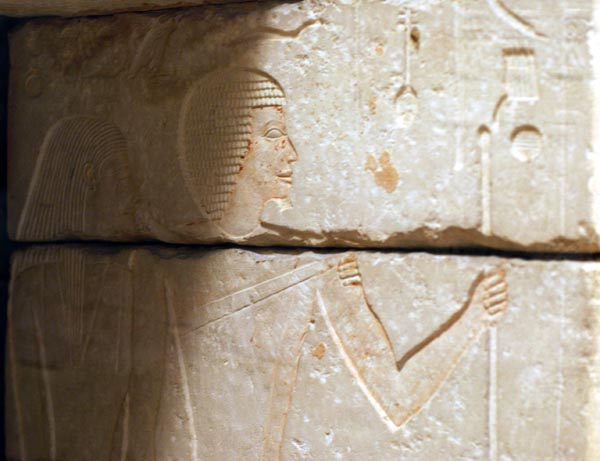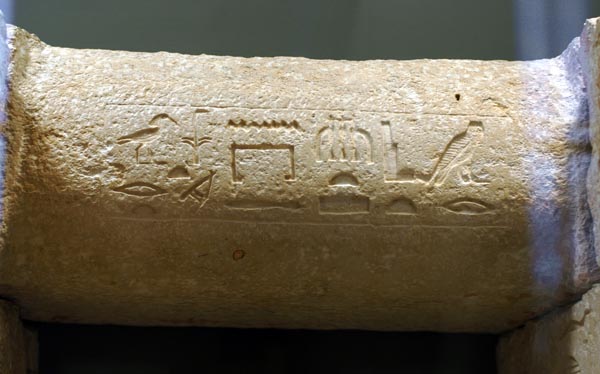
The excavation of the mastaba was begun on Tuesday, February 13, 1912, by Clarence Fisher, an assistant to Reisner working with the Harvard University-Museum of Fine Arts Expedition. The quality and the interesting features of its decoration were immediately apparent. According to the preliminary report, Fisher considered this mastaba "in many respects the finest small mastaba ever found by the Expedition."' The unusual content and style of the paintings in the room with the statue so impressed Reisner that he asked Mrs. Firth, the wife of a British archaeologist working nearby, to make watercolour drawings of the scenes. These watercolours have become an important record, since the scenes were almost entirely effaced by water damage in a shipboard fire during their transport to Boston. The present reconstruction is based on Mrs. Firth's copies, supplemented by Reisner's excavation photographs and some additional watercolours by Fisher. Not until 1935 were the seven shafts in the body of the mastaba excavated. Four of them contained features of interest. Shaft B contained a skeleton and a limestone coffin lid; shaft C contained another skeleton, while shaft E held a wooden coffin in which were the bones of two later burials. Although no burial remained in shaft G, a rectangular pit had been cut in its stone floor and fitted with a lid to form a built-in coffin.'
Three different versions of the mastaba chapel were built. In each version, Akh-Meret-Nesut devoted the principal southern niche to his own and his wife's cult, while providing a cult place for his parents at the lesser northern niche.
First Version
The earliest form of the mastaba had a simple one-room chapel, chamber A, cut into the southern end of the east face of the stone-encased mastaba and itself lined with stone. This chapel had two false doors: a southern one for Akh-Meret-Nesut himself and a northern one shared with his wife (for a discussion of the false door, see essay on funerary customs). The room had been entered prior to Reisner's excavations and the tablet of the northern false door removed. It is now in the Smith Collection of Egyptian Antiquities at the Linkoping Museum in Sweden. These doors formed the entire west wall of the chapel, separated only by an area painted in red to imitate patterned hangings. A figure of Akh-Meret-Nesut was painted on the south wall of the chapel.
The only other decoration at this period was outside the chapel, on the eastern face of the mastaba. At the northern half of this face, balancing the entrance to the chapel at the southern end of the same face, a small stone false door with only a single pair of jambs was set into the mastaba. Its tablet depicts Akh-Meret-Nesut's parents at an offering table; while the lintel below gives the name of his father and its drum bears the name of his mother. To the left (south) of it was an even tinier door, one course of masonry high. It consisted only of a lintel and drum with the name of Akh-Meret-Nesut's father.
The version of the chapel reconstructed in the exhibition represented a major change in the architecture of the tomb. The mastaba itself was considerably enlarged, and the earlier chapel blocked off by a false door. (This closed-off room may have served as a serdab [though no statue was found in it at the time of the excavation.) The south face of the mastaba was extended to the east, blocking the "street" between G 2184 and the large mastaba to the east of it, G 5090. In the space thus appropriated, another small stone-lined chapel, chamber B, was created. It opened at the north into a courtyard in front of the false doors of Akh-Meret-Nesut's parents. This courtyard was also constructed by blocking off the areas between existing buildings with mud brick walls. In one corner of the courtyard, the northwest corner of mastaba G 5080 intruded, making the space somewhat irregular. The decoration of these areas was far more elaborate than that of the previous version. In the niche formed by blocking the door to chamber A, a false door was erected. The lintel and side pillars from the first version of the door were left intact, and the doorway was partially blocked. Above the niched face on the blocking stones was a tablet showing Akh-Meret-Nesut at a table of offerings. (This tablet was briefly described in the earliest accounts of the excavations, but has since disappeared.)
In front of the false door was the square limestone
 offering-table and the seated statue of Akh-Meret-Nesut. A slightly
smaller space to the right of the table might have contained a smaller statue of either Akh-Meret-Nesut or his wife. The
round offering dish found broken in the courtyard may also have originally been put in this area. On each side of this
niche several registers of scenes were painted directly on the stone.
offering-table and the seated statue of Akh-Meret-Nesut. A slightly
smaller space to the right of the table might have contained a smaller statue of either Akh-Meret-Nesut or his wife. The
round offering dish found broken in the courtyard may also have originally been put in this area. On each side of this
niche several registers of scenes were painted directly on the stone.On the left (southern) face of the niche are five registers: in the bottom register, three men wrestle a bull to the earth in order to butcher him, above this, three men bring bundles of papyrus from the marshes. In the third register, a cow is being milked; her head turned with concern to her bleating calf, who looks longingly at the pot of milk from which he is held back by another herdsman. In the fourth, a spotted cow gives birth to a calf, to the intense interest of a passing dog; a herdsman crouches behind ready to beat off the dog if it attempts to interfere. The top register shows a larger scene. Akh-Meret-Nesut, who wears a handful of marsh flowers draped over one shoulder, stands in a papyrus skiff spearing fish (the artist has extended the water up in front of the prow of the boat to show the skewered fish more clearly). Next to him in the skiff sits his wife, steadying his leg with one hand and grasping a blossom in the other. Behind them is a papyrus thicket, full of birds of every kind and two oversized dragonflies; while in the water below the skiff, two hippos are attacking a crocodile, whose tail lashes out above the water and seems likely to upset the placid domestic vignette above.
To the right of the false door, in the lower two registers, men lead a bull and an oryx to be slaughtered. Above this a scene labelled crossing the canal [by] the herdsmen," shows two men in a boat and another in the water, assisting cattle to ford a canal. In the water below are two crocodiles; one is shown entire, the other only as a head abruptly appearing above the surface of the water. One of the men in the boat holds out his hand in a gesture meant to ward off danger. Two registers above show boats and the top register contains two men who
wear yokes with loaded baskets at each end.
Painted scenes also decorate the two walls flanking the niche. To the left a narrow panel shows animals and other offerings. In the lowest register, an unidentifiable animal is led in, and above this are scenes of butchers at work. The third register shows men leading in two hyenas, which were domesticated and raised for meat by the ancient
Egyptians. The hyenas were drawn on a much larger scale than the men, which is quite common in this tomb. In most of these scenes, both animals and men were drawn as large as the height of the register allowed, so their relative proportions are distorted. The register above this shows piles of offerings, including bread in various shapes and sizes. Above it is a register showing cuts of meat on little platforms, and at the top, two more registers of offerings.
The wall to the right (north) of the niche is longer, but unfortunately only four registers of its interesting decoration are preserved. The lowest register is a conventional one, showing three men leading cattle in for slaughter. The second register shows goats at their various activities. To the right, four goats nibble at the vegetation on two trees, two of them climbing right up into the branches to nibble at the tender top branches. To the left one goat gives birth and two others copulate, while a baby goat and a rather malevolent-looking cat look on. The male goat's horns extend up into the register above, lending him an impetuous appearance. To the far right of the third register the goat theme concludes in a rather macabre reflection of the tree-climbing scene just below: a tanner skins a goat that hangs by its heels from the upper branch of a tree.
In the winnowing scene in the centre of this register, a man tosses wheat into the air with a pitchfork so that the lighter chaff will blow away. To the left of this a very unusual scene shows men loading grain into granaries by leaning down from the upper part of the domed building and lifting baskets of grain from the heads of the men below. The register above contains still more grain processing scenes: the threshing of the wheat by donkeys is the comic centre piece, in which a man raises a stick to discourage the tired donkeys from stopping in their tracks to nibble the grain at their feet. To the left are the feet of the tomb owner, who leans lazily on his staff, his faithful dog at his feet, watching the activity in this register as well as several lost registers above.
The south wall of this chapel also seems to have been painted, but only small areas have been preserved.' Reisner saw on this wall only bands of geometric patterns; these bands are actually part of a patterned mat upon which Akh-Meret-Nesut and his wife are seated. Their feet and lower legs are faintly visible, and there is enough detail visible to establish that the woman is wearing a dress of net beads forming a diamond pattern on the white sheath she wears beneath it. There are also traces of the wooden seat on which the couple is sitting, which, like the seat on the tablet of the false door, seems to have crossed in front of the wife's legs. In front of the pair is an offering table upon which a round loaf of bread was painted; another round object was part of a pile below it.
Only three registers of decoration on the east wall can be reconstructed. The top register shows a fishing expedition, in which the men at left are pulling in either end of a large net full of fish, straining at their ropes while the overseer and his dog look on. To the right some of the same fishermen carry home their catch in a large round basket. The lower two registers probably represent a banquet. In the upper one are entertainers, dancers, clapping women, a man playing the transverse flute and a singer at the far right. In the lowest register sit the guests: several of Akh-Meret-Nesut's male dependents at right (one named Inkhi), and to the left, five women, including three of his sisters, one of whom is named after Khufu. Akh-Meret-Nesut would probably have stood at the south end of the wall enjoying the party.
No further decoration is recorded in this room; however the courtyard, which seems to have been open to the sky, was also decorated with painted scenes that probably date to the same phase of the renovation. The doorway between the painted chapel and the courtyard, which was put in during this phase, was of finely carved stone; the eastern reveal shows Akh-Meret-Nesut and his wife, and the western reveal shows his parents. The lintel, drum and jambs are inscribed with his names and titles.
On the west side of the courtyard, against the battered stone wall of the original face of the mastaba, a niched facade was built up with mud bricks. This facade contained four niches, all plastered and brightly painted with patterns in imitation of woven mats or cloth hangings. In the third panel from the south end, the top part of the niched facade was cut back to reveal the original false-door tablet of Akh-Meret-Nesut's mother and father that had formed part of the first phase of the mastaba's decoration, and continued to serve as a cult place in the second version.
The remainder of the decoration in the courtyard was painted on plaster, and because of its fragility was preserved only to the height of the middle of the first register, which seems to have contained primarily herds of animals and their herdsmen. One vignette has been copied from this area, showing two dogs attacking a wounded oryx, perhaps part of a hunting scene. This band of scenes began at the eastern edge of the stone door jamb and wrapped around the corner of mastaba G 5090 which jutted into the courtyard at its southeast corner, continuing on the east wall. It cannot be determined whether the curved wall at the north end of the courtyard was built during this phase or belonged to the final stage of modification, nor can it be said whether this wall or the angled wall beneath it were originally plastered and painted.
The final change in mastaba G 2184 was less extensive than the previous one, though it may have been more expensive. It probably included narrowing the entrance to the courtyard by adding the rounded wall described above, but the major change was to cover the west wall of the courtyard with a stone facade decorated with painted sunk relief texts and scenes. The stone facade includes two false doors, the southern one dedicated to Akh-Meret-Nesut, and the northern one - almost directly over the original northern niche on the mastaba face - again dedicated to his parents. Between the false doors is a scene of Akh-Meret-Nesut receiving a foreigner and recalcitrant tax-payers who are led in by his brothers, all in attitudes of submission.
To the north of the northern false door is an unusual scene of Akh-Meret-Nesut swinging back his lasso. As elsewhere in the tomb, the artist here used an off-balance stance to depict a single frozen moment of action. Akh-Meret-Nesut's lasso is swung back over the panelling of the false door, as though the hunt were taking place in front of the stone facade rather than on its surface. This scene is made especially intriguing by the fact that there was no animal depicted to make a target for the lasso, and there is no place on the west wall where an animal of this scale could be restored. One possibility that has been suggested' is that the target animal was depicted on the curved wall just opposite this scene; a very unusual conceit, and one that would have made the entering visitor feel as though he had just walked into the middle of a rodeo ring.
In spite of the different phases in which the mastaba was decorated, all of the scenes in this tomb chapel and courtyard share a liveliness and verisimilitude that is unknown from other Giza mastabas of this period. The pose of an overseer or even a tomb owner slouching against his staff is not common in the Old Kingdom; it occurs four times in this tomb, once on the stone facade of version three. The frequent jokes, the graphic innovations such as the crocodile shown only as a head that has suddenly appeared from the water, and the cases in which a part of the scene is extended beyond the register boundaries point to artists who were unusually inventive in their portrayal of movement and of such emotions as surprise, fear, and lust. It is tempting to suggest that the same artist directed both the paintings of the second version and the carving of the final addition.
Neferet-Sedjem, the wife of Akh-Meret-Nesut, was given no titles in the tomb. Their son, who was also named Akh-Meret-Nesut, is shown as a small boy in the latest stage of the decoration. Four brothers of Akh-Meret-Nesut are also depicted in this stage: Seneb, Peshes, Nefer-netjer, and the steward Ka-heb.
Because the tomb was decorated in three different stages, it is possible to say something about the course of Akh-Meret-Nesut's career. In the earliest stage he bears his father's title, King's Acquaintance, but he already has a higher title, Overseer of the Place of Hnty-Ss of the Palace. It is not certain exactly who the people called Hnty-S were but it seems probable that they were personal servants of the king. In one text Akh-Meret-Nesut is given the title Inspector of the same place, a step below his final rank, so apparently he had already had a promotion by the time he began to decorate his small tomb.
In the second phase of building, Akh-Meret-Nesut has added the title Overseer of the Royal Palace. The hry-a were apparently craftsmen of some sort, while the s likely has the same meaning as it has in the title Hnty-S, so probably this was simply an extension of his previous responsibilities. An inscription in the newer part of the tomb, however, notes that "His majesty made this for him, in order that he might be venerated." The modification of his mastaba chapel was thus a mark of royal favour.
The final modification of the mastaba chapel was also a royal gift: a text states: "It is his lord who made this." In this part of the chapel, Akh-Meret-Nesut has added his latest title, "wab-priest of the king," to his earlier titles. This was his first priestly office, and probably records his attendance upon the king at some religious ceremony.
The like-named son of Akhet-Meret-nesut may have continued in his father's position. In mastaba G 2421, a lintel was found bearing the name Akhet-Meret-nesut and the title overseer of Hnty-Ss, reused there to fill up a doorway. If this lintel was not taken from the tomb of the elder Akh-Meret-Nesut (there is no obvious place in that tomb to restore it), it may have been taken from a lost chapel built by his son.

